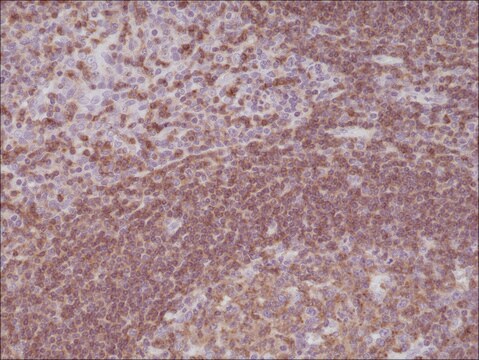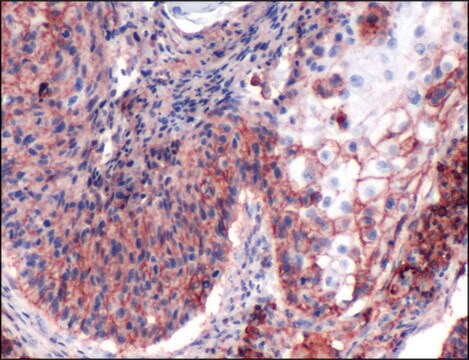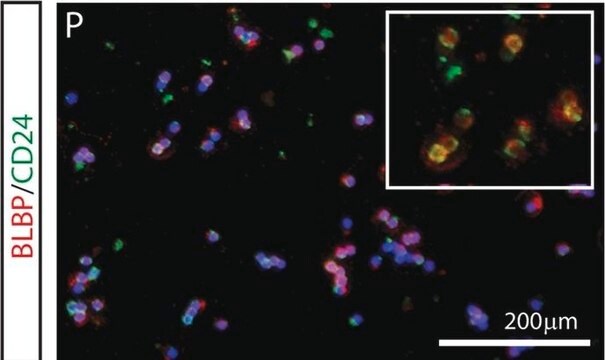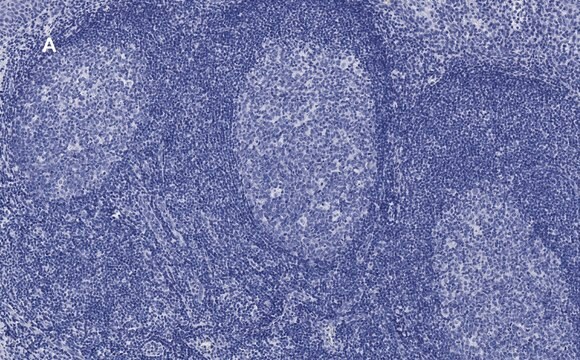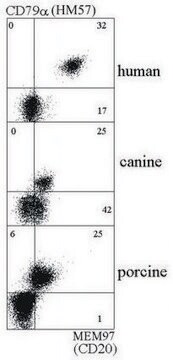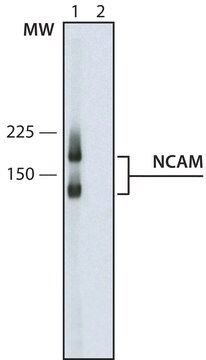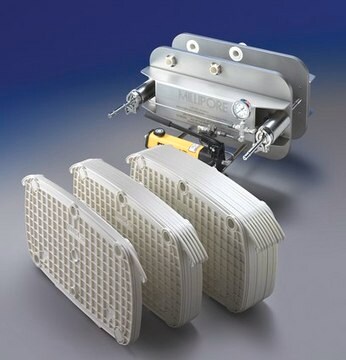SAB4700179
Monoclonal Anti-CD44 antibody produced in mouse
clone MEM-85, purified immunoglobulin, buffered aqueous solution
Synonym(s):
Anti-Pgp-1
Sign Into View Organizational & Contract Pricing
All Photos(1)
About This Item
UNSPSC Code:
12352203
NACRES:
NA.41
Recommended Products
biological source
mouse
Quality Level
conjugate
unconjugated
antibody form
purified immunoglobulin
antibody product type
primary antibodies
clone
MEM-85, monoclonal
form
buffered aqueous solution
species reactivity
human
concentration
1 mg/mL
technique(s)
flow cytometry: suitable
isotype
IgG2b
NCBI accession no.
UniProt accession no.
shipped in
wet ice
storage temp.
2-8°C
target post-translational modification
unmodified
Gene Information
human ... CD44(960)
Related Categories
General description
The antibody MEM-85 reacts with both cell surface-expressed and soluble form of CD44 antigen (Phagocyte glycoprotein 1), a 80-95 kDa transmembrane glycoprotein (hyaladherin family) present on the most of cells and tissues (leukocytes, endothelial cells, mesenchymal cells, etc.); it is negative on platelets and hepatocytes.
Immunogen
Leukocytes of a patient suffering from LGL Type Leukaemia.
Application
Applications in which this antibody has been used successfully, and the associated peer-reviewed papers, are given below.
Flow cytometry/Cell sorting (1 paper)
Flow cytometry/Cell sorting (1 paper)
Features and Benefits
Evaluate our antibodies with complete peace of mind. If the antibody does not perform in your application, we will issue a full credit or replacement antibody. Learn more.
Physical form
Solution in phosphate buffered saline, pH 7.4, with 15 mM sodium azide.
Disclaimer
Unless otherwise stated in our catalog or other company documentation accompanying the product(s), our products are intended for research use only and are not to be used for any other purpose, which includes but is not limited to, unauthorized commercial uses, in vitro diagnostic uses, ex vivo or in vivo therapeutic uses or any type of consumption or application to humans or animals.
Not finding the right product?
Try our Product Selector Tool.
Storage Class Code
10 - Combustible liquids
Flash Point(F)
Not applicable
Flash Point(C)
Not applicable
Choose from one of the most recent versions:
Already Own This Product?
Find documentation for the products that you have recently purchased in the Document Library.
Qifei Wang et al.
Molecular medicine reports, 13(6), 4636-4642 (2016-04-16)
The aim of the present study was to evaluate the different expression levels of thyroid hormone responsive (THRSP; Spot14)/S14 related, Mig12 (S14R) during bone marrow mesenchymal stem cell (BM-MSC) adipogenesis in adolescent idiopathic scoliosis (AIS) patients. MSCs were retrospectively isolated from
Hong-Min Li et al.
Life sciences, 106(1-2), 50-57 (2014-05-02)
Inducible nitric oxide synthase (iNOS) over-expression is considered critical to the death of transplanted cells in infarcted myocardium. The present study was to investigate the effect of iNOS on the survival of transplanted bone marrow mesenchymal stem cells (BMSCs) in
Grant R Kolar et al.
Blood, 109(6), 2545-2552 (2006-11-30)
We have identified a novel mature human B-cell subpopulation in the human tonsil that has characteristics of both naive B cells and germinal center B cells including the expression of activation-induced cytidine deaminase (AID), which is essential for the process
Bin Bao et al.
Stem cells and development, 23(16), 1947-1958 (2014-04-17)
Pancreatic cancer (PC) is one of the most deadly cancers. The higher mortality is in part due to treatment resistance and early onset of metastasis. The existence of cancer-stem-like cells (CSLCs) has been widely accepted to be responsible for tumor
Mark J Modelski et al.
Biology of reproduction, 91(5), 109-109 (2014-09-19)
To initiate the crucial cell adhesion events necessary for fertilization, sperm must penetrate extracellular matrix barriers containing hyaluronic acid (HA), a task thought to be accomplished by neutral-active hyaluronidases. Here we report that the ~57 kDa hyaluronidase 2 (HYAL2) that
Our team of scientists has experience in all areas of research including Life Science, Material Science, Chemical Synthesis, Chromatography, Analytical and many others.
Contact Technical Service